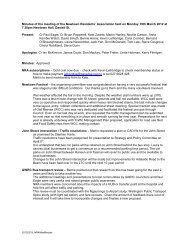Draft Town Belt Management Plan - Wellington City Council
Draft Town Belt Management Plan - Wellington City Council
Draft Town Belt Management Plan - Wellington City Council
Create successful ePaper yourself
Turn your PDF publications into a flip-book with our unique Google optimized e-Paper software.
The <strong>Council</strong> will no longer hold a grievance with the Crown on behalf of the citizens of <strong>Wellington</strong>,<br />
but will work with the Crown and PNBST concerning land that has been ‘lost’ from the <strong>Town</strong> <strong>Belt</strong> as<br />
originally set aside by the New Zealand Company.<br />
2.7 Proposed approach to <strong>Town</strong> <strong>Belt</strong> additions<br />
Regaining the original 1841 boundary of the <strong>Town</strong> <strong>Belt</strong> is unrealistic considering the way the <strong>City</strong> has<br />
developed. A majority of the alienated original <strong>Town</strong> <strong>Belt</strong> land has either been subdivided into private<br />
residential property or used for a community purpose, such as <strong>Wellington</strong> Hospital and Victoria<br />
University. The <strong>Council</strong>’s policy is to recognise and provide for the continued operation and<br />
development of <strong>Wellington</strong> Hospital and Victoria University.<br />
The proposed priorities focus on protecting existing <strong>Town</strong> <strong>Belt</strong> land from any further reduction,<br />
strengthening its continuity and open-space values through land additions and boundary<br />
adjustments, and ensuring formal legal <strong>Town</strong> <strong>Belt</strong> status of land identified to be added to the <strong>Town</strong><br />
<strong>Belt</strong>.<br />
It is the <strong>Council</strong>’s intention to continue to protect the existing <strong>Town</strong> <strong>Belt</strong> through the provisions of<br />
the 1873 <strong>Town</strong> <strong>Belt</strong> Deed.<br />
In situations where removal of <strong>Town</strong> <strong>Belt</strong> land occurs outside the <strong>Council</strong>’s control (eg by the central<br />
government through legislation), the <strong>Council</strong> will pursue the replacement of this land with open<br />
space land of equal value or character to be returned to the <strong>Town</strong> <strong>Belt</strong>.<br />
There are three categories of land that could potentially be added to the <strong>Town</strong> <strong>Belt</strong>. They are:<br />
1. Land alienated from the original <strong>Town</strong> <strong>Belt</strong> but still suitable for <strong>Town</strong> <strong>Belt</strong> purposes<br />
This includes:<br />
• land currently owned by the <strong>Council</strong> but not protected by the Deed. For example, former Vice<br />
Regal, Chest Hospital, and Telecom land and Stellin Memorial Park. These areas are included<br />
in this management plan.<br />
• land currently owned by the Crown or Crown agency. This land is now subject to the Port<br />
Nicholson Block (Taranaki Whānui ki Te Upoko o Te Ika) Claims Settlement Act 2009 giving<br />
Taranaki Whānui the right of first refusal to acquire when any of these properties are declared<br />
surplus (See 2.9.5). This land includes:<br />
• land at Clifton Terrace (former Correspondence School site)<br />
• land at Abel Smith Street (open-space land adjacent to Te Aro School)<br />
• part of the <strong>Wellington</strong> College<br />
• part of Government House (this land is not covered by the right of first refusal<br />
provisions).<br />
2. Existing <strong>Council</strong> reserve land not part of the original <strong>Town</strong> <strong>Belt</strong><br />
This includes:<br />
• land that strengthens the original <strong>Town</strong> <strong>Belt</strong> concept such as Point Jerningham, Western<br />
Slopes Reserve and the Rangiohua lands, and<br />
• land that extends the <strong>Town</strong> <strong>Belt</strong> concept area such as Tawatawa ridge and Houghton Valley<br />
reserves.<br />
3. Small pieces of land identified through <strong>Town</strong> <strong>Belt</strong> boundary adjustments<br />
In 1994, as part of the preparation of the 1995 <strong>Town</strong> <strong>Belt</strong> <strong>Management</strong> <strong>Plan</strong>, the <strong>Council</strong><br />
completed a <strong>Town</strong> <strong>Belt</strong> land status investigation. This identified some legal anomalies relating to<br />
the <strong>Town</strong> <strong>Belt</strong> boundaries. For example:<br />
• where roads have divided the land and created small unworkable alienations so that the land<br />
effectively functions as road reserve<br />
18<br />
<strong>Draft</strong> <strong>Town</strong> <strong>Belt</strong> <strong>Management</strong> <strong>Plan</strong> October 2012





